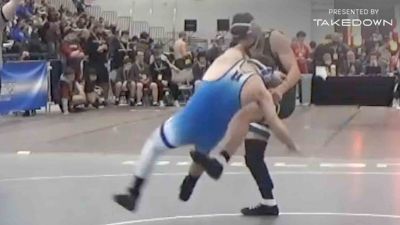How To Score A High School Wrestling Match
How To Score A High School Wrestling Match
Here's how wrestling scores get assigned in high school wrestling matches.

High school wrestling matches take place in either dual meet or tournament formats. Each match is three periods long, and each period lasts for two minutes.
Matches can be ended early either by fall, by technical fall, by injury default (if one of the wrestlers is unable to finish the match), or by disqualification (if one of the wrestlers receives too many penalty points). At the end of regulation, the wrestler with the most points is declared the winner. If the score is tied, matches are decided in overtime.
Wrestling Starting Positions
In order to understand individual wrestling scoring, it's important to establish the basic wrestling positions, neutral and referee's position.
- Neutral - In the neutral position, both wrestlers begin on their feet. From neutral, wrestlers can work to secure takedowns.
- Referee's Position - In referee's position, the bottom wrestler begins on the center of the mat on his or her hands and knees. The top wrestler places one hand on the bottom wrestler's elbow and the other hand on the bottom wrestler's naval. The top wrestler puts the near knee beside the wrestler on the same side as the elbow and places the other knee behind the bottom wrestler. In referee's position, bottom wrestlers work to escape or earn reversals while top wrestlers work to score nearfall points or secure falls.
Wrestling Scores For Individual Matches
- Takedown (2 points) - A takedown is awarded when one wrestler takes the other wrestler to the mat and secures control by getting on top behind the hips.
An example of a takedown
- Escape (1 point) - An escape is awarded when the bottom wrestler in referee's position gets to his or her feet, gets free from the top wrestler, and turns to face the top wrestler.
- Reversal (2 points) - A reversal is awarded when the bottom wrestler in referee's position moves from the bottom position to the top position by gaining control of the wrestler who started in the top position.
- 2-Point Nearfall (2 points) - A 2-point nearfall is awarded when, in referee's position, the top wrestler exposes the bottom wrestler's shoulder to the mat at a 45-degree angle for 2, 3, or 4 consecutive seconds.
- 3-Point Nearfall (3 points) - A 3-point nearfall is awarded when, in referee's position, the top wrestler exposes the bottom wrestler's shoulder to the mat at a 45-degree angle for 5 or more consecutive seconds.
- Stalling - A stalling call can be made when the referee determines that one of the wrestlers is avoiding action. This can happen by backing out of bounds or engaging in other behavior that avoids action. The first time a wrestler is called for stalling in a match will result in a warning, the second or third stall call will result in the wrestler's opponent being awarded 1 point. The fourth and fifth stall calls will result in the stalling wrestler's opponent being awarded 2 points, and the sixth stall call will result in disqualification.
- Penalty Point - Wrestlers can be penalized for illegal holds, for technical violations like grasping the uniform or equipment, or for unsportsmanlike conduct. 1st penalty - 1 point; 2nd penalty - 1 point; 3rd penalty - 2 points; 4th penalty - 2 points; 5th penalty - disqualification. A full penalty chart from the NFHS is available here.
- Caution - A caution will be called when one of the wrestlers moves before the referee blows the whistle to begin or restart competition either from neutral or from referee's position. The first two cautions result in a warning, but the third caution and any subsequent cautions result in penalty points.
Team Scoring For Dual Meets
Dual meet team score is the result of team points awarded to the winning wrestler of each match. Winning wrestlers receive between three and six team points depending on their margin of victory. The following are the kinds of victories a wrestler can earn:
- Decision (3 Points) - a match won by between 1 and 7 match points.
- Major Decision (4 Points) - a match won by between 8 and 14 match points.
- Technical Fall (5 Points) - a match won by 15 more match points. Once a wrestler has a lead of 15 or more points, the match is terminated.
- Fall/Pin (6 Points) - a match in which one wrestler puts any part of both of their opponent's shoulders on the mat for two consecutive seconds. Any pin terminates the match.
- Forfeit (6 Points) - six team points will be awarded to one team if they present a wrestler to compete at a weight and the other team does not present an opponent at that weight.
- Injury Default or Disqualification (6 Points) - If one wrestler is injured in a match and is unable to continue, the other wrestler will be awarded a victory by injury default, and the winning wrestler's team will be awarded six points. If a wrestler is disqualified for exceding their allotment of penalties or because they injure their opponent with an illegal move, the winning wrestler's team will be awarded six points.
